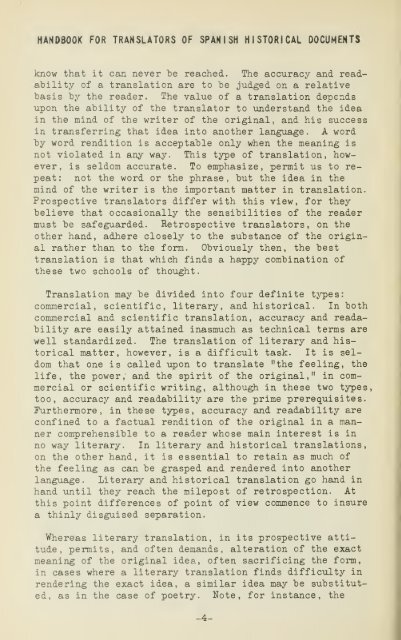Handbook for translators of Spanish historical ... - University Library
Handbook for translators of Spanish historical ... - University Library
Handbook for translators of Spanish historical ... - University Library
You also want an ePaper? Increase the reach of your titles
YUMPU automatically turns print PDFs into web optimized ePapers that Google loves.
HANDBOOK FOR TRANSLATORS OF SPANISH HISTORICAL DOCUMENTS<br />
know that it can never "be reached. The accuracy and readability<br />
<strong>of</strong> a translation are to "be judged on a relative<br />
basis by the reader. The value <strong>of</strong> a translation depends<br />
upon the ability <strong>of</strong> the translator to understand the idea<br />
in the mind <strong>of</strong> the writer <strong>of</strong> the original, and his success<br />
in transferring that idea into another language. A word<br />
by word rendition is acceptable only when the meaning is<br />
not violated in any way. This type <strong>of</strong> translation, however,<br />
is seldom accurate. To emphasize, permit us to repeat:<br />
not the word or the phrase, but the idea in the<br />
mind <strong>of</strong> the writer is the important matter in translation.<br />
Prospective <strong>translators</strong> differ with this view, <strong>for</strong> they<br />
believe that occasionally the sensibilities <strong>of</strong> the reader<br />
must be safeguarded. Retrospective <strong>translators</strong>, on the<br />
other hand, adhere closely to the substance <strong>of</strong> the original<br />
rather than to the <strong>for</strong>m. Obviously then, the best<br />
translation is that which finds a happy combination <strong>of</strong><br />
these two schools <strong>of</strong> thought.<br />
Translation may be divided into four definite types:<br />
commercial, scientific, literary, and <strong>historical</strong>. In both<br />
commercial and scientific translation, accuracy and readability<br />
are easily attained inasmuch as technical terms are<br />
well standardized. The translation <strong>of</strong> literary and <strong>historical</strong><br />
matter, however, is a difficult task. It is seldom<br />
that one is called upon to translate "the feeling, the<br />
life, the power, and the spirit <strong>of</strong> the original," in commercial<br />
or scientific writing, although in these two types,<br />
too, accuracy and readability are the prime prerequisites.<br />
Furthermore, in these types, accuracy smd readability are<br />
confined to a factual rendition <strong>of</strong> the original in a manner<br />
comprehensible to a reader whose main interest is in<br />
no way literary. In literary and <strong>historical</strong> translations,<br />
on the other hand, it is essential to retain as much <strong>of</strong><br />
the feeling as can be grasped and rendered into another<br />
language. Literary and <strong>historical</strong> translation go hand in<br />
hand until they reach the milepost <strong>of</strong> retrospection. At<br />
this point differences <strong>of</strong> point <strong>of</strong> view commence to insure<br />
a thinly disguised separation.<br />
Whereas literary translation, in its prospective attitude,<br />
permits, and <strong>of</strong>ten demands, alteration <strong>of</strong> the exact<br />
meaning <strong>of</strong> the original idea, <strong>of</strong>ten sacrificing the <strong>for</strong>m,<br />
in cases where a literary translation finds difficulty in<br />
rendering the exact idea, a similar idea may be substituted,<br />
as in the case <strong>of</strong> poetry. Note, <strong>for</strong> instance, the<br />
-4-










![Novellen [microform] - University Library](https://img.yumpu.com/21939450/1/171x260/novellen-microform-university-library.jpg?quality=85)
![Anecdota Chisiana de re metrica [microform]](https://img.yumpu.com/21939448/1/190x239/anecdota-chisiana-de-re-metrica-microform.jpg?quality=85)



![Schollenbruch [microform] : Gedichte - University Library](https://img.yumpu.com/21939437/1/174x260/schollenbruch-microform-gedichte-university-library.jpg?quality=85)

